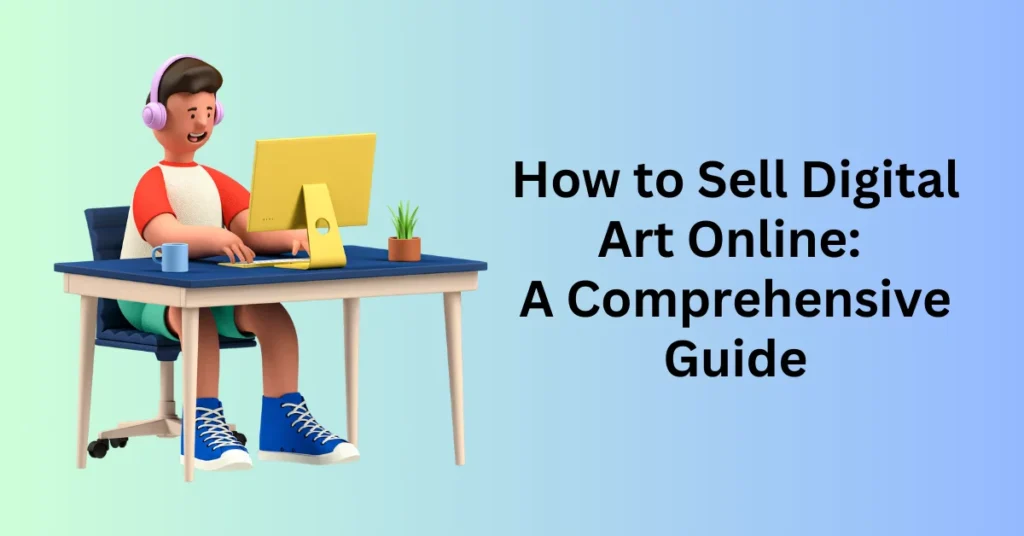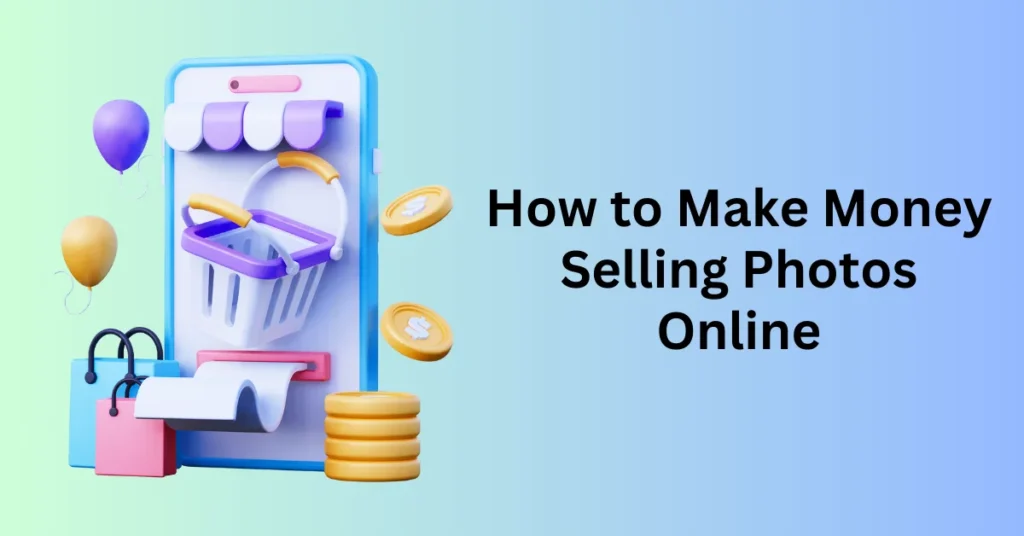Are you an artist looking to turn your passion for digital art into a profitable venture? Or perhaps you’ve been dreaming of sharing your creations with a global audience but weren’t sure where to start. Either way, in 2025, the opportunities for selling digital art online are more exciting and accessible than ever before. With the rise of user-friendly tools, diverse platforms, and innovative business models, building an online art store and successfully marketing your products has never been easier.
Whether you’re a seasoned artist or a newcomer to the digital art world, this guide will help you get started. Firstly, we’ll cover the best platforms for selling your work, from popular marketplaces like Etsy and Shopify to print-on-demand services that allow you to launch your business with zero upfront costs. In addition, you’ll learn how to leverage these platforms to transform your designs into high-quality products like apparel, home décor, and digital downloads—all while keeping your overhead low and your creativity high.
Ready to make your mark in the digital art space? Let’s explore the tools, techniques, and strategies you’ll need to turn your artistic vision into a thriving online business.
What is a Digital Art?
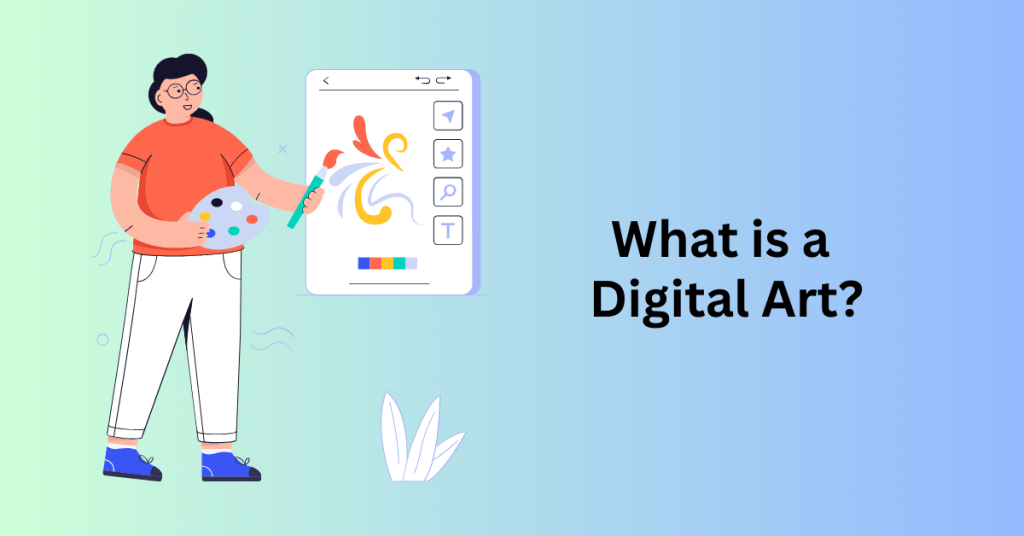
Digital art encompasses any creative work that relies on digital technology for its creation or enhancement. This broad category includes a wide range of artistic expressions, from traditional art reimagined through digital tools to entirely new mediums made possible by modern software and hardware. Moreover, the versatility of digital art enables artists to produce works that can be static, animated, or interactive, expanding the possibilities for creative exploration and audience engagement. As a result, digital art has become a dynamic and ever-evolving field that continues to push the boundaries of artistic expression.
Common Forms of Digital Art
- Digital Painting and Illustration
These artworks are created directly on digital platforms using specialized tools like styluses and graphic tablets. Artists use software such as Adobe Photoshop, Procreate, or Corel Painter to mimic the textures and techniques of traditional mediums, like oil painting or watercolour, while benefiting from the flexibility and precision of digital tools. - 3D Modeling and Animation
Used extensively in gaming, film, and virtual reality, 3D modelling involves creating objects, characters, and environments in three dimensions. Animation takes this further by bringing these creations to life with movement. Popular tools for this form include Blender, Maya, and Cinema 4D. - Photo Manipulation and Digital Photography
Beyond capturing images with digital cameras, photographers often enhance or transform their work using editing software like Adobe Lightroom or Photoshop. Digital manipulations can range from subtle adjustments to creating entirely surreal compositions. - Pixel Art
This retro-inspired art form uses tiny square pixels to create images, reminiscent of early video game graphics. It has become a niche but popular medium for creating visually striking, low-resolution art. - Interactive and Multimedia Art
Combining elements like video, sound, and animation, this form invites the viewer to engage with the artwork. Often used in installations, websites, or apps, it blends creativity with technology to produce immersive experiences. - Crypto Art and NFTs
Crypto art is a modern innovation where digital artworks are turned into unique assets on blockchain technology. These are often sold as Non-Fungible Tokens (NFTs), making each piece verifiable and unique in ownership. Artists in this space use platforms like OpenSea and Rarible. - Mixed Media Art
This involves blending traditional techniques like sketching or painting with digital elements. For example, an artist might scan a hand-drawn illustration and enhance it using digital textures or colors.
Popular Digital Products in the Marketplace
Digital art isn’t just about creating visuals—it’s also a thriving industry. Many artists produce digital products for both personal and commercial use. Top-selling digital items include:
- Wallpapers: Designs for phone, tablet, and desktop screens.
- Stock Images: High-quality photos and graphics for use in marketing, blogging, and design projects.
- Coloring Pages: Printable or interactive pages for both kids and adults.
- Editable Templates: Customizable graphics for presentations, social media posts, or planners.
- Fonts: Unique typefaces created for branding, design, and personal projects.
- Website Templates: Pre-designed layouts for platforms like WordPress, Shopify, or Wix.
- Fan Art: Original works inspired by popular movies, games, and books, often sold as prints or digital downloads.
Digital art is more than just a method of creating—it’s a dynamic, ever-evolving medium that bridges the gap between creativity and technology. It continues to expand with new tools, platforms, and opportunities, offering endless possibilities for artists and audiences alike.
Is Selling Digital Art Online Profitable?
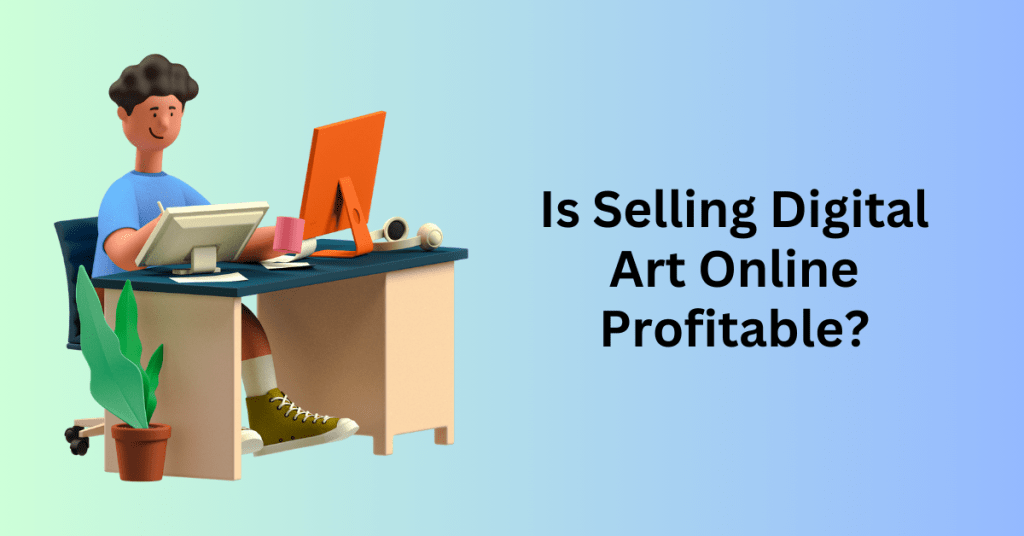
Selling digital art online has proven to be a lucrative venture, with the global art market witnessing tremendous growth in recent years. By 2023, online art sales were valued at nearly $12 billion, a dramatic increase from 2019. This rise highlights the growing demand for digital artworks and the vast opportunities available for artists in the digital space.
Why Is Selling Digital Art Profitable?
- The Rise of NFTs
Blockchain technology has introduced Non-Fungible Tokens (NFTs), a game-changer for the art world. NFTs provide a way for artists to authenticate and monetize their digital creations, turning them into unique, collectible assets. Selling NFTs can be particularly profitable, especially when tied to high-demand niches or exclusive collections. Artists can further capitalize on this trend by offering NFT-themed merchandise, such as custom printable posters or designs. - Global Accessibility
Digital art transcends geographic barriers, allowing artists to sell their work to audiences worldwide. Platforms like Etsy, Gumroad, and ArtStation make it easier than ever to reach customers, whether they’re looking for high-quality prints, downloadable files, or customizable designs. - Scalability and Low Overhead Costs
Unlike traditional art, where physical materials and shipping can add significant expenses, digital art is created and delivered entirely online. This low overhead cost means artists can keep more of their profits, and selling a single piece as a downloadable file allows unlimited distribution without additional effort.
Keys to Success in Selling Digital Art Online
Selling digital art online can be a profitable and fulfilling venture when approached strategically. To succeed, it’s essential to focus on key areas that align with both your artistic skills and market trends.
One of the first steps is identifying a target niche. By specializing in a specific audience or theme, you not only align your work with your interests but also increase your chances of standing out. For example, popular niches include fan art inspired by movies, games, or books; minimalist and abstract designs for home decor; and custom illustrations for branding, social media, or events. Understanding your niche allows you to tailor your products and marketing strategies to resonate with your ideal customers, making your offerings more attractive and relevant.
Equally important is building a strong online presence. Platforms such as Instagram, Pinterest, and TikTok are excellent tools for showcasing your art, connecting with potential buyers, and driving traffic to your store. By sharing engaging content—such as behind-the-scenes videos, process tutorials, or time-lapse reels—you can help establish credibility and create a sense of community around your work, which in turn encourages support and purchases.
Adopting a cost-effective business model is also crucial. A popular approach is utilizing Print on Demand (POD) services, which allow you to sell physical products like mugs, t-shirts, or posters without the need to manage inventory or shipping logistics. This model not only reduces financial risks but also eliminates upfront costs, as items are produced only when sold.
To maximize income, it’s important to offer a diverse range of products. Beyond physical items, consider creating digital products such as device wallpapers, editable templates for planners or social media, digital stickers for messaging apps, or coloring pages for kids and adults.
How to Turn Digital Art Files Into Profit
Transforming your digital art into a profitable venture involves two primary approaches: selling digital products or converting your designs into physical items. Whether offering downloadables on platforms like Etsy or creating tangible merchandise, these strategies enable artists to monetize their creativity effectively. Here’s an in-depth look at both methods and the best business strategies for each.
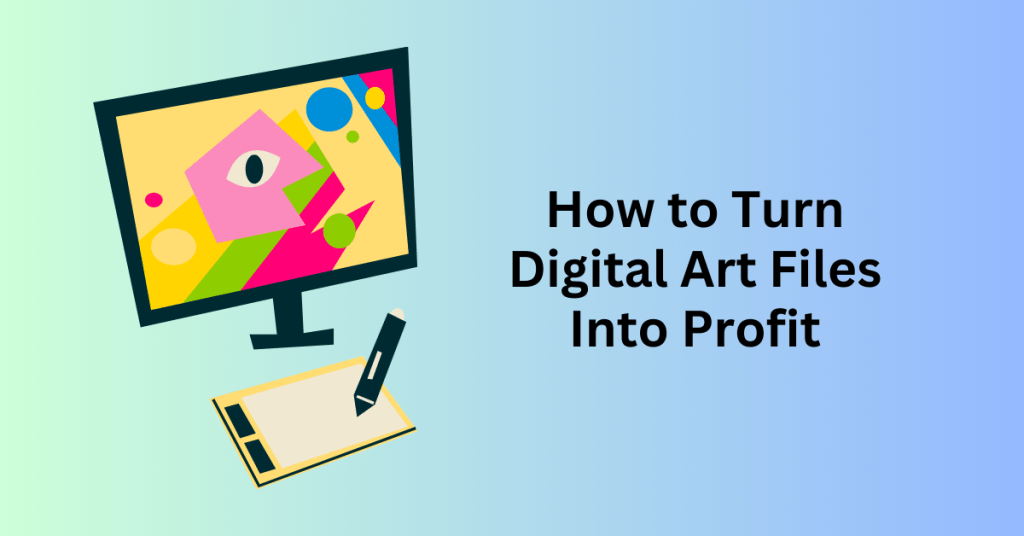
1. Selling Artwork as Digital Products
Selling digital downloads is one of the simplest ways to begin profiting from your art. Customers purchase digital files to print themselves or use as digital assets, making this approach cost-effective and scalable.
Selecting the right platform is crucial for reaching your target audience. Here are some top options:
- Social Media: Platforms like Instagram and TikTok are ideal for showcasing your art. By posting eye-catching visuals and engaging content, you can attract buyers directly and link them to your store or offer commissions.
- Online Marketplaces: Sites like Etsy or Creative Market provide tools for creating listings and reaching audiences actively searching for unique digital downloads.
- Stock Image Platforms: For photography, graphic design, and mixed media, consider selling on Adobe Stock or Shutterstock, where buyers seek high-quality, royalty-free assets.
- Your Own Website: Build a personalized eCommerce store with platforms like Shopify, WooCommerce, or Wix. This gives you full control over branding, pricing, and customer experience.
- Commission Sites: Offer custom creations tailored to individual clients through platforms like DeviantArt or Fiverr. Promote these services on social media with clear pricing and examples of your work.
Each platform has unique benefits, so choose one that aligns with your art style and business goals.
Sell Digital Art as NFTs
Non-Fungible Tokens (NFTs) enable artists to sell exclusive digital pieces verified through blockchain technology. While this market caters to a niche audience, it offers lucrative opportunities for high-value sales. Popular platforms like Rarible, Foundation, and Nifty Gateway are great starting points.
Tip: Research the process for creating NFTs, and consider initial costs like gas fees. Branding, community engagement, and timing are critical to success in this space.
2. Selling Digital Art as Physical Products
Turning your digital files into physical items not only expands your revenue streams but also appeals to a broader audience. For instance, products ranging from apparel to home decor provide a higher perceived value, creating opportunities for repeat sales.
Furthermore, POD services streamline the process of creating and selling physical products. With platforms like Printify, you can easily upload your designs, choose the products, and have the service manage both production and shipping. As a result, this eliminates the need for inventory or upfront investment, making it simpler than ever to enter the physical products market.
Best Physical Products for Digital Art
- Canvas Prints, Posters, and Wall Art
- Posters are budget-friendly and popular for decorating dorms or personal spaces. Opt for premium options like matte or water-resistant silk posters.
- Canvas prints provide a professional aesthetic, with options like eco-friendly pinewood frames for sustainable buyers.
- Wall art appeals to customers looking for statement pieces to enhance their living spaces.
- Merchandise
- T-Shirts: Universally loved and versatile, t-shirts are perfect for showcasing bold designs or niche themes. Explore unisex options in various fabrics and colors.
- Sweatshirts: Ideal for casual wear, hoodies and crewneck sweatshirts offer a durable canvas for larger, detailed designs.
- Socks: All-over printed socks are a trendy item that adds flair to any outfit.
- Phone Cases: Design polycarbonate, impact-resistant cases that keep your art with customers daily.
- Tote Bags: Popular for their practicality, totes featuring unique art are both functional and fashionable.
- Stationery
- Notebooks: Spiral-bound notebooks with vibrant covers are perfect for students, professionals, or art enthusiasts.
- Cards: Seasonal greeting cards and postcards are affordable and in high demand for holidays or special occasions.
Tips for Success in Selling Digital Art
To succeed in selling digital art, it’s crucial to develop a clear strategy that showcases your unique style and resonates with your target audience. One effective way to stand out in a crowded market is by specializing in a specific art style or theme. For example, popular niches like fan art, minimalist designs, and abstract patterns not only attract diverse audiences but also allow you to carve out your own space within the market.
Equally important is having a strong promotional strategy. Leverage social media platforms such as Pinterest, Instagram, and TikTok to both showcase your art and connect with potential buyers. Sharing engaging content—such as tutorials, process videos, or behind-the-scenes glimpses—can help build a loyal following. These platforms also provide an opportunity to foster a sense of community, which can lead to valuable word-of-mouth promotion.
Additionally, diversifying your product offerings can significantly maximize your income potential. By combining digital downloads, such as printable wall art or device wallpapers, with physical products like t-shirts, mugs, or posters featuring your designs, you can cater to different customer preferences and broaden your revenue streams.
To ensure that your products meet professional standards, it’s important to use high-quality design tools like Adobe Illustrator, Photoshop, or Canva Pro. These professional-grade tools enable you to create print-ready, high-resolution files that produce sharp and vibrant physical products, ensuring customer satisfaction and encouraging repeat business.
Ultimately, success in selling digital art requires a balance of creativity and smart business practices. Whether you focus on downloadable products, NFTs, or physical merchandise, the possibilities for monetizing your art are limitless. By staying consistent, adapting to trends, and fostering meaningful connections with your audience, you can transform your passion for art into a steady source of income.
Finding Your Niche and Marketing Your Digital Art
Successfully selling digital art begins with finding your niche—a specific style, theme, or subject matter that makes your work stand out and appeals to a particular audience. A well-defined niche not only highlights your unique artistic voice but also helps you attract customers who resonate with your work.
How to Identify Your Niche
The first step in identifying your niche is to explore what you love to create. Consider the themes, styles, or subjects that inspire you the most. Aligning your niche with your passions ensures you’ll stay motivated and consistent in producing art over the long term. Whether it’s whimsical illustrations, bold abstract designs, or intricate patterns, choosing something you genuinely enjoy will make the creative process more rewarding.
Your niche should also cater to an audience with a specific interest. To better understand your potential customers, study where they spend time online and what type of content they engage with. For example, Instagram is ideal for visually-driven niches such as illustrations, portraits, or aesthetic designs. Etsy works well for artists offering printable wall art, planners, or niche merchandise. Reddit provides access to niche communities interested in themes like anime art, vintage aesthetics, or mental health advocacy. Meanwhile, Pinterest serves as a hub for inspirational and aspirational art, especially in categories like home decor, motivational quotes, and custom designs.
It’s also important to observe trends within your potential niche. Identifying popular styles can help you create art that aligns with customer preferences. For instance, anime-inspired landscape art often appeals to fans of fantasy and gaming. Minimalist fairytale illustrations attract modern book lovers, while vintage-inspired designs resonate with planners and stationery enthusiasts. Additionally, custom pet portraits remain a favorite for animal lovers.
If you’re unsure which niche fits you best, take time to experiment. Share work in different styles or themes and track the engagement you receive. This trial period allows you to discover what resonates most with your audience and pinpoint where demand lies. Over time, this approach will help you refine your niche and build a loyal customer base.
Examples of Digital Art Niches
- Fantasy and Anime Fusion: Landscape or character art blending whimsical themes with vibrant, anime-inspired styles.
- Mental Health Motivational Art: Uplifting quotes and calming designs targeted at individuals seeking positivity and mindfulness.
- Custom Portraits: Pet portraits, family illustrations, or stylized individual pieces for gifting purposes.
- Game Graphics: Artwork for children’s games, including icons, sprites, and backgrounds.
- Vintage Aesthetics: Old-world charm in modern formats, like planner stickers or printable art.
Crafting a Marketing Plan for Your Niche
- Build an Online Presence
Share your work on platforms frequented by your target audience. Each platform has unique advantages:- Instagram: Showcase your process, share behind-the-scenes content, and use hashtags to increase visibility.
- Pinterest: Create pins with keyword-optimized descriptions to drive traffic to your store or portfolio.
- TikTok: Share quick art creation videos or time-lapses to connect with younger audiences.
- Engage with Your Community
- Participate in niche-specific forums or groups on Reddit, Facebook, or Discord.
- Respond to comments and messages to build relationships with followers.
- Share relatable content, such as memes or stories tied to your niche, to foster a sense of community.
- Leverage Content Marketing
- Educational Content: Post tutorials or tips related to your niche to establish expertise.
- Storytelling: Share the inspiration behind your pieces to connect emotionally with your audience.
- Trendy Challenges: Participate in art challenges or viral trends to reach a broader audience.
- Run Promotions
Offer discounts, limited-edition prints, or giveaways to boost engagement and attract new buyers. - Use Paid Ads
If you have a clear target audience, consider using platforms like Facebook, Instagram, or Pinterest Ads to expand your reach. Target by interests, demographics, or behaviors to ensure your ads are shown to the right people.
A focused niche helps you stand out in a crowded market, build a loyal customer base, and establish a recognizable brand. By consistently producing art that aligns with your niche, you’ll position yourself as an expert in that area, increasing the likelihood of repeat customers and word-of-mouth referrals.
By aligning your passion with audience demand and strategically marketing your work, you can build a thriving digital art business that resonates with your target market.
Protecting Your Art: Essential Tips for Artists
In the digital age, protecting your creative work from theft or misuse is a significant concern. While risks exist, implementing proactive measures can help safeguard your art and reduce vulnerabilities.
Secure Payment Practices
To avoid financial fraud and ensure safe transactions, follow these payment best practices:
- Request Payment Upfront: Always require full payment before delivering digital or physical products. This prevents potential issues with nonpayment after delivery.
- Choose Reliable Payment Methods: Stick to trusted options for processing payments. Avoid promises of cash payments or risky methods like paper checks or transfers from unknown foreign accounts, which are prone to failure or fraud.
Reliable Payment Methods Include:
- Online Payment Gateways: Services like PayPal, Stripe, or Square.
- Third-Party Marketplaces: Platforms like Etsy or Shopify provide secure transactions.
- Email Invoicing: Issue detailed invoices via secure email platforms.
- Mobile Payment Apps: Use apps such as Venmo or Zelle for fast and trackable payments.
- Electronic Bank Transfers: Direct transfers through trusted banking institutions.
- Cryptocurrency Payments: For tech-savvy buyers, cryptocurrencies like Bitcoin offer secure and decentralized transactions.
Using these tools minimizes the risk of scams and ensures a smoother payment process.
Safeguarding Digital Art
One common issue for digital artists is the unauthorized use or resale of their files. Preventative measures can help deter potential thieves:
- Add Watermarks or Signatures: Overlay watermarks or artist signatures on your digital assets before sharing them online. This makes unauthorized use more challenging.
- Share Low-Resolution Previews: For commissions or online promotions, provide low-quality preview images that aren’t suitable for reproduction. Deliver high-quality versions only after payment is complete.
- Use Copyright Notices: Display a clear copyright notice on your website, social media pages, or digital files, explicitly stating that unauthorized use is prohibited.
Protecting Your Work Through Licensing
Establishing a commercial license ensures legal protection for your art and clearly defines how buyers can use it. A license allows you to maintain control over reproduction, distribution, and resale.
How to Create and Implement a Commercial License:
- Draft Terms of Use: Write specific terms outlining acceptable and prohibited uses of your work.
- Utilize Marketplace Tools: Many platforms offer built-in licensing options:
- Etsy: Include a custom license agreement in your product listing, specifying whether the artwork is for personal or commercial use.
- Adobe Stock: Uploading your art automatically comes with licensing terms that protect your work while allowing specific buyer uses.
- Shutterstock: The platform manages licensing, ensuring buyers adhere to predefined usage rights.
- For Your Website: Create a standalone license file outlining usage restrictions. Make it easily accessible as a downloadable PDF or a visible disclaimer on each product page.
Pro Tip: For added protection, consult with a legal professional to ensure your licensing terms align with copyright laws in your region.
Sell Your Art with Printify: Turn Your Designs into Profitable Products
If you’re looking to transform your digital art into real-world products, Printify’s print-on-demand service provides the easiest and most affordable way to do so. With no inventory management or upfront costs to worry about, you can focus entirely on your creativity while we take care of production and shipping.
From custom t-shirts and mugs to posters and even notebooks, our platform offers you the flexibility to sell your art on over 1,000 different products. This allows you to reach a broader audience and diversify your offerings, all while minimizing the logistical hassle.
How It Works:
Here’s a rewritten version with transition words included:
Create Your Printify Account: First, sign up for free to gain access to a vast selection of customizable products. This allows you to start creating and selling without any hidden fees or minimum orders.
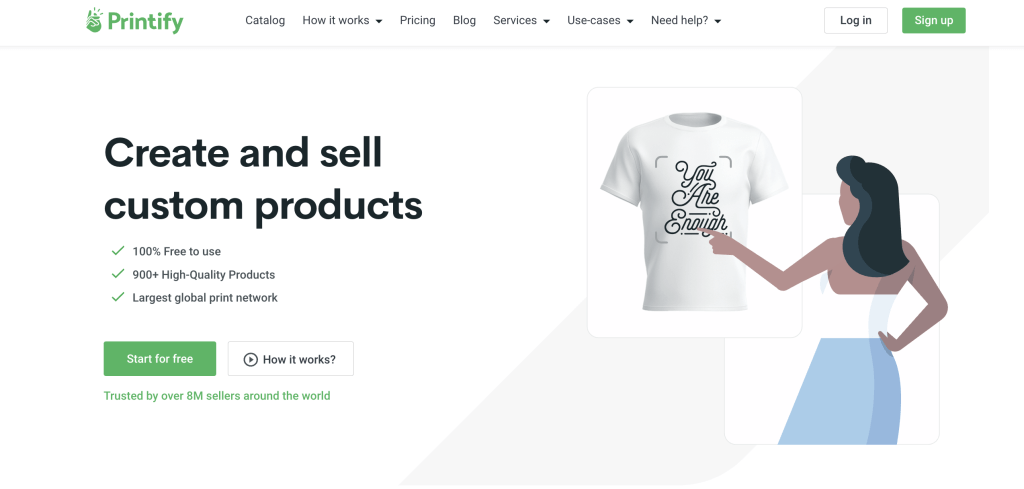
Choose Your Product: Next, browse our extensive catalog to find the perfect product for your artwork. You can use filters to narrow down options based on pricing, production location, or any specific features you may need, such as branding opportunities.
Upload and Design Your Art: After choosing your product, head to the Product Creator tool to upload your designs. Be sure to ensure that your artwork meets our recommended resolution and file specifications for the best print quality. Additionally, you can tweak your design and view it on product mockups, allowing you to ensure everything looks perfect before moving forward.
Integrate with Your eCommerce Platform: Then, easily connect Printify to your online store, whether it’s on Etsy, Shopify, or WooCommerce. With just a few clicks, your designs will sync to your storefront, and we’ll handle the rest, including order fulfillment and shipping. To integrate seamlessly, simply click “Add new store” near your profile icon and choose your sales platform.
Start Selling Your Art: Finally, now that everything’s set up, it’s time to publish your designs! Set your prices, hit “Publish,” and your products will be live and ready for sale. Promote your artwork to your audience, and soon, your creations will turn into revenue.
Printify makes it simple to turn your digital art into high-quality, physical products ready to sell online. Whether you’re just starting or looking to expand, our platform offers everything you need to launch your art-based business with minimal effort and no upfront costs.
Final Thoughts: Transforming Your Creativity into a Thriving Business
Selling your digital art online is more than a potential income stream—it’s also an opportunity to connect with a global audience and share your unique creativity. For instance, whether you’re offering digital downloads, taking custom commissions, or building a product line with print-on-demand services, the possibilities are both vast and exciting.
To succeed, it’s essential to begin by crafting a solid business plan that aligns with your goals. Once that foundation is in place, the next step is to focus on building a strong online presence by leveraging social media, creating your own website, or utilizing popular marketplaces. Additionally, actively engaging with your audience is crucial for building trust and fostering loyalty. Furthermore, don’t forget to protect your intellectual property in order to safeguard your work. At the same time, experiment with different platforms to discover what works best for your niche. Moreover, continuously analyzing and refining your approach will ensure you stand out in the competitive world of digital art.
Ultimately, with persistence, a clear strategy, and a commitment to your craft, your artistic passion can evolve into a sustainable and profitable venture. There’s no better time to start—so begin creating, sharing, and selling your art today!
